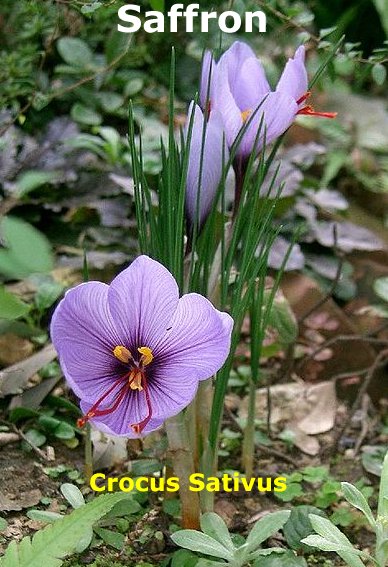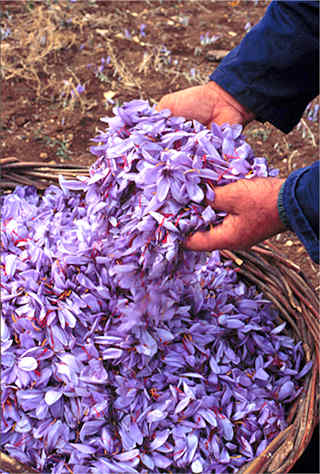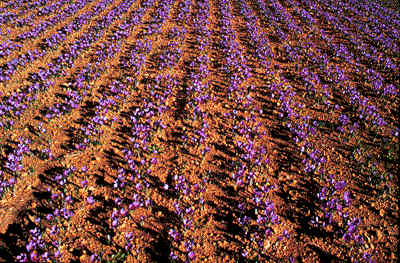
"A mere fraction of a gram utterly transforms a dish--in favor, aroma and spectacular color. Breathtakingly expensive at
thousands of dollars per pound, saffron is used in unique luxury items such as chocolate, cosmetics, and vodka. Saffron's unmistakable scent and
taste are signature notes in such famous dishes as Bouillabaisse and Paella."
by Robert Hercz, Tony van Roon
Centuries ago, spices weren't just seasonings. They were material evidence of a new world of marvels beyond the horizon.
Today, our planet is small and familiar and not very much surprises us, yet there is still one spice that captures the wonder of that long-ago time: saffron.
Part of the reason is price. When the spice trade was young, only the wealthy could buy delicacies like pepper or vanilla. Those and most other spices
are now easily affordable, but saffron, at thousands of dollars a pound, remains breathtakingly expensive. Then there is the mysterious potency of
saffron's fragile red threads. A pinch, just a fraction of a gram, completely transforms a dish--not just its flavor and aroma, but, quite
spectacularly, its color as well.
Saffron's unmistakable smell (a combination of hay and honey) and taste (pleasantly bitter, slightly metallic) are signature notes in many famous dishes,
including France's Bouillabaise, Spain's paella Valencia, Italy's risotto alla Milanese and India's biryanis. And finally, there is its provenance. The
threads that constitute saffron are actually female sex organs (the stigmas) of a small--and, ironically, sterile--purple flower. saffron is nothing
if not exotic, and the more you learn, the more exotic it becomes.
Saffron is by far the world's most expensive spice because it is too fragile to be handled by machine. Every step in its production, from planting to
packaging, is entirely (and painstakingly) done by hand. For two weeks in October, fields of purple Crocus Sativus flowers appear in the
world's main saffron-growing regions--Iran, Spain and India. Early each morning, teams of pickers, bent almost double to reach the 12-inch-high
flowers, harvest the blooms that are just about to open, so that the flower's closed petals protect the delicate stigmas.
The same afternoon, practiced hands fold the petals back and pluck the three red threads inside.
 The stigmas must be dried immediately, either over embers or in the
sun, to protect them from mould and decay. During this process, they lose 80 percent of their weight. A kilogram of dried saffron represents 150,000
crocus flowers--almost half a million stigmas--and 400 hours of back-breaking and hand-numbing labor.
The stigmas must be dried immediately, either over embers or in the
sun, to protect them from mould and decay. During this process, they lose 80 percent of their weight. A kilogram of dried saffron represents 150,000
crocus flowers--almost half a million stigmas--and 400 hours of back-breaking and hand-numbing labor.
That kilogram, if it is top quality, might fetch $10,000 in retail, but only a tenth of that goes to the croker, as crocus farmers are known. In the
developed world, saffron is associated with luxury (recent offerings include saffron vodka, chocolates and cosmetics), but to the families that grow it,
saffron is just one of several crops they must bring in to make ends meet.
Humans have been using saffron for thousands of years and not just for cooking. The oldest unambiguous reference to saffron--in a Greek fresco dating
from 1500 BCE--depicts women gathering and making medicine from crocus flowers; another image shows saffron treating a bleeding foot. In fact, the
ancients believed saffron could cure almost anything. The Greeks used it for kidney diseases and to stimulate the appetite. Alexander the Great
sprinkled it into his bath water to heal his wounds. Cleopatra sprinkled it into her bath water to enhance love-making. The Romans stuffed their
pillows with it to prevent hangovers; when that failed, they added it to wine to cure hangovers. In 1670, Crocologia, an entire volume about
saffron, was published by a German physician who opined that it would cure toothache, the plague and, when combined with snails and earthworms, jaundice.
On the Indian subcontinents, saffron is still used in Ayurvedic Medicine to prevent diabetes and treat liver disease, urinary problems and rheumatism.
Next to medicine, saffron's most important early use was not as a spice but as a dye. Although its threads are deep orange-red, saffron--the word
comes from za'faran, the Arabic word for yellow--was named for the rich gold color it dyes cloth (and food). Saffron dyed clothes were the
mark of high caste in India, royalty in Ireland and holiness in the familiar "saffron robes" of Buddhist monks, which were, in fact, usually dyed with
less-expensive turmeric.
Saffron was also used to dye hair (by Alexander the Great amongst others), to color (rather than flavor) food, and as a cheaper (although not cheap)
substitute for gold leaf on Medieval paintings and manuscripts. Its coloring power has become idiom in India, where people speak of "saffronizing the
truth" and "saffronizing History."
Saffron's pleasantly sharp, haylike aroma has also been exploited. It was the perfume of the hetaerae, the most sophisticated (and expensive) courtesans
of ancient Greece. Saffron was used to perfume the streets of Rome before Nero made his entrance. For the same reason--to mask the stench of the
crowd--the citizens of Rhodes wore pouches of saffron when they went to the theater.
The spice has always been costly. During the Middle Ages, a pound of saffron bought a horse, and a few pounds of saffron corms (bulbs) served as
collateral for a loan. Mediterranean pirates were known to ignore shipments of gold in favor of saffron. One theft of 800 pounds of saffron destined
for Basel, Switzerland, ignited a three-month Saffron War of 1374. Although the shipment was recovered, Basel began growing its own saffron and
prospered as a result--until the crop failed 10 years later and the project was abandoned.
Adulteration is an inevitable result of saffron's price, and it has a long history. Almost 2,000 years ago, Rome's Pliny the Elder complained that
saffron was "frequently falsified." The deceptions, which continue to this day, include adding similar looking (but not tasting) plants such as
marigold petals, safflower ("Mexican saffron"), beet fibers and even strands of red silk. Ground saffron is adulterated with paprika or turmeric
powder (the main ingredient in "Indian saffron," a double deception since real Indian saffron, grown in Kashmir, is considered the best in the world).
Some dealers weigh down their wares by coating the stigmas with honey, wax or oil. But the simplest and most common form of deceit is
mislabeling--selling lower quality saffron as Kashmiri, for example.
 In 15th century Germany, rampant fraud resulted in the passage of the safranschou code, which left no doubt about the seriousness of
adulteration. One dealer was dragged through the streets by a horse, then eviscerated and finally buried, still alive, his mouth stuffed with bags of
his impure goods. Another was burned alive, the pyre kindled with his adulterated saffron.
In 15th century Germany, rampant fraud resulted in the passage of the safranschou code, which left no doubt about the seriousness of
adulteration. One dealer was dragged through the streets by a horse, then eviscerated and finally buried, still alive, his mouth stuffed with bags of
his impure goods. Another was burned alive, the pyre kindled with his adulterated saffron.
On a pleasanter note, many cultures have noted that saffron makes you happy, even giddy. In ancient Persia, saffron tea was a cure for depression,
and in Iran today they still say that if you eat too much saffron you could laugh yourself to death. Sir Francis Bacon, the great English essayist
and philosopher, maintained it was saffron that "maketh the English sprightly."
(There was a large saffron-growing industry in England during Tudor times, centered around the Essex town of Saffron Walden, formerly Cheppinge Walden.
Demand declined in the early 17th century, partly because the Puritan movement, which objected to the spicing of food, was gaining strength.)
But using saffron to achieve euphoria is not recommended. The stigmas are toxic in large doses, and no one should consume more than a 1-1/2 grams a
day, even if they can afford it. Above that level, unpleasant side effects begin to appear, starting with vomiting and escalating from there. Very
high doses--sources disagree about the amounts, but not the result--are fatal.
On the other hand, the ancients who thought saffron was good medicine may have been onto something. Research has shown that compounds in saffron are
effective against a wide range of tumors (although so far, only in petri dishes and mice), giving us another reason to be just mad about saffron.
Buying and using Saffron:
THE FIRST THING TO EMPHASIZE ABOUT SAFFRON is that there is no substitute. A recipe might suggest turmeric or safflower ("Mexican saffron")
instead, but all that will give you is a saffron-like color. Noting can replace the flavor and aroma of real, high-quality saffron. The second
thing to emphasize is that, as an old adage goes, "saffron is expensive to buy but cheap to use." Its flavor notes--bitter and metallic--are only
wonderful in tiny quantities. Too much give food a medicinal taste. A gram of saffron cost $10, but will flavor 20 to 40 dishes.
UNFORTUNATELY, YOU CAN'T USUALLY TASTE OR SMELL SAFFRON WHEN YOU'RE BUYING IT, so you have to shop with your eyes. As a general rule, the
deeper the color, the higher the grade. Look for vivid crimson threads with no broken-up debris at the bottom of the package. The threads naturally
have white or pale yellow ends (styles), but these have little potency and should be a very small fraction of the whole. In very high (i.e.
expensive) grades (coupe in Spanish, sargol in Iranian), these ends are trimmed. Avoid ground saffron because it is easy to adulterate
and it doesn't keep very long. Whole saffron can be stored (in a cool, dark place) for at least three years; ground saffron should be used within
one year.
ALTHOUGH SAFFRON IS GROWN IN MANY PLACES, some of them quite unexpected--New Zealand, California, Switzerland and even, lately, Afghanistan as
a substitute for poppies--most of the saffron you will come across will be Iranian, because 90 percent of the world's saffron is grown in Iran.
There's a good chance it will be labelled Spanish, however, since most of Iran's crop is exported in bulk to Spain, where it is repackaged for retail
sale. But its citizenship is unimportant; all regions produce both high- and low-quality saffron. What matters is the flavor.
SAFFRON RELEASES ITS FLAVOR SLOWLY. Unless you're making a slow-cooked meal, it is best to soak saffron in warm water (saffron is water-soluble;
it cannot be extracted in oil or butter) for at least 20 minutes and up to 24 hours. Then add the solution, threads and water, to the dish while it is
cooking.
Credits:
Robert Hercz is a Toronto-based writer. He has written for The New York Times, Saturday Night, Toronto Life, Toro, Harry and other magazines.
Tony van Roon is a free-lance writer based in Cambridge, Ontario. He writes electronic tutorials, movie scripts, and science fiction novels. This
article is re-written and edited by Tony van Roon, 2009.
Last updated: January 05, 2011
Copyright © 2008, LCBO Food&Drink, Tony van Roon.


 The stigmas must be dried immediately, either over embers or in the
sun, to protect them from mould and decay. During this process, they lose 80 percent of their weight. A kilogram of dried saffron represents 150,000
crocus flowers--almost half a million stigmas--and 400 hours of back-breaking and hand-numbing labor.
The stigmas must be dried immediately, either over embers or in the
sun, to protect them from mould and decay. During this process, they lose 80 percent of their weight. A kilogram of dried saffron represents 150,000
crocus flowers--almost half a million stigmas--and 400 hours of back-breaking and hand-numbing labor. In 15th century Germany, rampant fraud resulted in the passage of the safranschou code, which left no doubt about the seriousness of
adulteration. One dealer was dragged through the streets by a horse, then eviscerated and finally buried, still alive, his mouth stuffed with bags of
his impure goods. Another was burned alive, the pyre kindled with his adulterated saffron.
In 15th century Germany, rampant fraud resulted in the passage of the safranschou code, which left no doubt about the seriousness of
adulteration. One dealer was dragged through the streets by a horse, then eviscerated and finally buried, still alive, his mouth stuffed with bags of
his impure goods. Another was burned alive, the pyre kindled with his adulterated saffron.